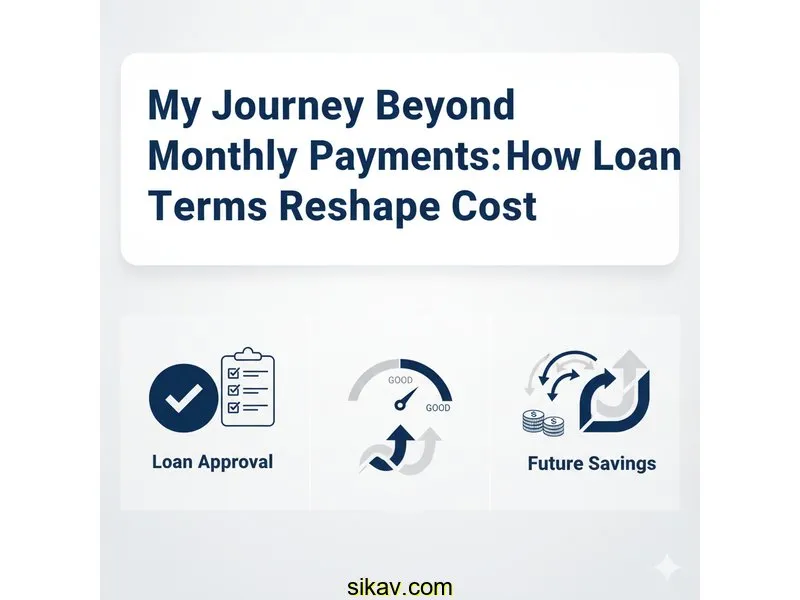
Auto Loan Calculator
Calculate payments over the life of your Loan
Home Blog Privacy Terms About Contact
Calculate payments over the life of your Loan
Home Blog Privacy Terms About ContactPublished on October 14, 2025

It all started with a simple chat over coffee. A friend mentioned they'd recently gotten a personal loan for some home improvements, and the amount was pretty similar to one I had been hypothetically modeling for myself. When they told me their monthly payment, I was genuinely surprised. It was almost a hundred dollars less than what I was seeing in my own calculations. For a moment, I thought I must have been using the online calculators all wrong.
My first instinct was to ask, "How did you get such a low payment?" But a different, more nagging question quickly took its place: "Is a lower monthly payment always the full story?" It felt like there was a piece of the puzzle I was missing. How could two similar loan amounts have such drastically different monthly costs? What was the hidden variable I wasn't seeing?
This wasn't about getting a loan or finding a better deal. It became a personal mission to understand the math. I wanted to pull back the curtain on how these numbers were generated and what they really meant. I decided to spend a weekend diving into online loan calculators, not as a shopper, but as a student trying to understand the mechanics behind the curtain. This is just my journey of learning how these calculations work; it is absolutely not financial advice.
My goal was simple: figure out why my friend's payment was lower and, in the process, teach myself how changing one number in a loan calculator could ripple through and change all the others. I wanted to move from just plugging in numbers to truly understanding the relationship between them. What I discovered fundamentally changed how I look at loan calculations forever.

Armed with a fresh cup of tea and a determination to figure this out, I opened a standard online loan calculator. I decided to create a baseline scenario to work from. I typed in a loan amount of $14,850, a common figure for things like used cars or significant projects. I then entered an interest rate of 7.8%, which seemed like a realistic middle-of-the-road number.
First, I put in a loan term of 48 months, or four years. The calculator instantly spit out a result: a monthly payment of around $361.64. That seemed reasonable. But then, to replicate my friend's situation, I changed only one variable: the loan term. I extended it to 72 months, or six years, keeping the loan amount and interest rate exactly the same.
The new monthly payment appeared: $258.97. There it was. A difference of over $100 per month. My initial thought was, "This is amazing! Why wouldn't everyone choose the longer term? It makes things so much more affordable on a monthly basis." I was completely focused on that single number, the monthly payment. It felt like the only metric that mattered because it directly related to a monthly budget.
But my initial curiosity wouldn't let it go. It still felt too simple. I started thinking, "Okay, I'm paying for a longer time... so what?" For a while, I was stuck. I kept toggling the term back and forth between 48 and 72 months, watching the monthly payment number go up and down. I was fixated on it, completely blind to the other information the calculator was showing me. Fields like "Total Principal Paid," "Total Interest Paid," and "Total Cost of Loan" were just noise to me. I didn't understand what they were trying to tell me, so I ignored them. My mistake was thinking the loan *cost* was the monthly payment, not realizing the true cost was buried in those other numbers I was skipping over.
My frustration was growing. I knew I was missing something obvious. I decided to slow down and look at every single output field on the calculator, not just the one I was obsessed with. I ran my two scenarios again, side-by-side on a piece of scratch paper, and this time, I wrote down everything the calculator told me. It was in that simple act of writing it all down that the lightbulb finally went on.
For the 48-month term, the "Total Interest Paid" was $2,508.72. For the 72-month term, that same field showed $3,795.84. I stared at those two numbers. The longer-term loan, the one with the "cheaper" monthly payment, would cost me over $1,200 more in interest. Suddenly, it all clicked into place. The monthly payment wasn't the price of the loan; the interest was. The lower monthly payment came at a significant cost, a cost I had been completely blind to just moments before.
My entire perspective shifted. I realized the monthly payment is a tool for managing cash flow, but the total interest paid is the number that reveals the true cost of borrowing money over time. It's not that one is "good" and one is "bad"; they just tell two very different stories about the same loan.
To solidify my understanding, I started doing the math by hand. I took the monthly payment and multiplied it by the term. For the 72-month loan, $258.97 times 72 equals $18,645.84. Then, I subtracted the original loan amount ($14,850) from that total. The result was $3,795.84—the exact number the calculator showed for "Total Interest Paid." The formula was so simple: Total Paid - Principal = Total Interest. Seeing the math connect like that was incredibly empowering.
I finally understood the fundamental trade-off. A longer loan term gives you more time, which reduces the amount you need to pay each month. However, because your loan balance remains higher for a longer period, you pay more interest over the life of the loan. It's a direct relationship: you are often paying for the convenience of a lower monthly payment with a higher total cost.
To test my newfound knowledge, I ran a completely different scenario: a $19,500 loan at 6.2%. I compared a 36-month term to a 60-month term. Sure enough, the same principle held true. The 60-month term had a much more attractive monthly payment, but the total interest paid was nearly double that of the 36-month option. My understanding was solid.
This deep dive into loan terms was more illuminating than I could have imagined. I didn't just find the answer to my original question; I gained a whole new literacy in how loan calculations work. The process taught me to be more curious about the numbers and to look at the complete picture, not just the most obvious figure.
Here are the key lessons about the calculations that have stuck with me:
I learned this is because interest is calculated on your outstanding balance. With a longer term, your principal balance decreases more slowly. This means you are borrowing the money for a longer period, so the lender has more time to charge interest on that remaining balance, leading to a higher total interest cost over the life of the loan.
From my exploration, I wouldn't call it "misleading," but rather "incomplete." A lower monthly payment is a real benefit for managing your monthly budget and cash flow. The key is understanding that this benefit often comes with a trade-off, which is a higher total cost. A calculator helps you see both sides of that trade-off so you can understand the full picture.
What worked for me was to input the exact same loan amount and interest rate for both scenarios. Then, change only the loan term (e.g., 48 months vs. 72 months). Don't just look at the monthly payment. Instead, place the "Total Interest Paid" or "Total Cost of Loan" fields for both scenarios side-by-side. The difference between those two numbers is the real financial impact of choosing the longer term.
The calculation that really made things click for me was this: (Monthly Payment) x (Number of Months in Term) = Total Payments. This simple multiplication shows you the total amount of money that will leave your bank account over the loan's life. When you compare that number to the original loan amount, you instantly see the total cost of interest.
My weekend journey that started with a simple question about a friend's loan payment ended up teaching me a fundamental lesson in financial literacy. The "aha!" moment wasn't about finding a "better" loan or saving money; it was about understanding the hidden relationship between time and money. I learned that the most appealing number at first glance, the low monthly payment, often hides the most important number: the total cost.
I feel so much more confident now, not in making financial decisions, but in my ability to understand the mechanics behind them. Playing with calculators and being curious about every field they offer is a powerful way to learn. It transforms them from simple answer machines into incredible teaching tools that let you explore "what if" scenarios and see for yourself how the math truly works.
This article is about understanding calculations and using tools. For financial decisions, always consult a qualified financial professional. My journey was about empowering myself with knowledge, and I hope sharing it helps demystify these concepts for others who are curious, too.
Disclaimer: This article documents my personal journey learning about loan calculations and how to use financial calculators. This is educational content about understanding math and using tools—not financial advice. Actual loan terms, rates, and costs vary based on individual circumstances, creditworthiness, and lender policies. Calculator results are estimates for educational purposes. Always verify calculations with your lender and consult a qualified financial advisor before making any financial decisions.